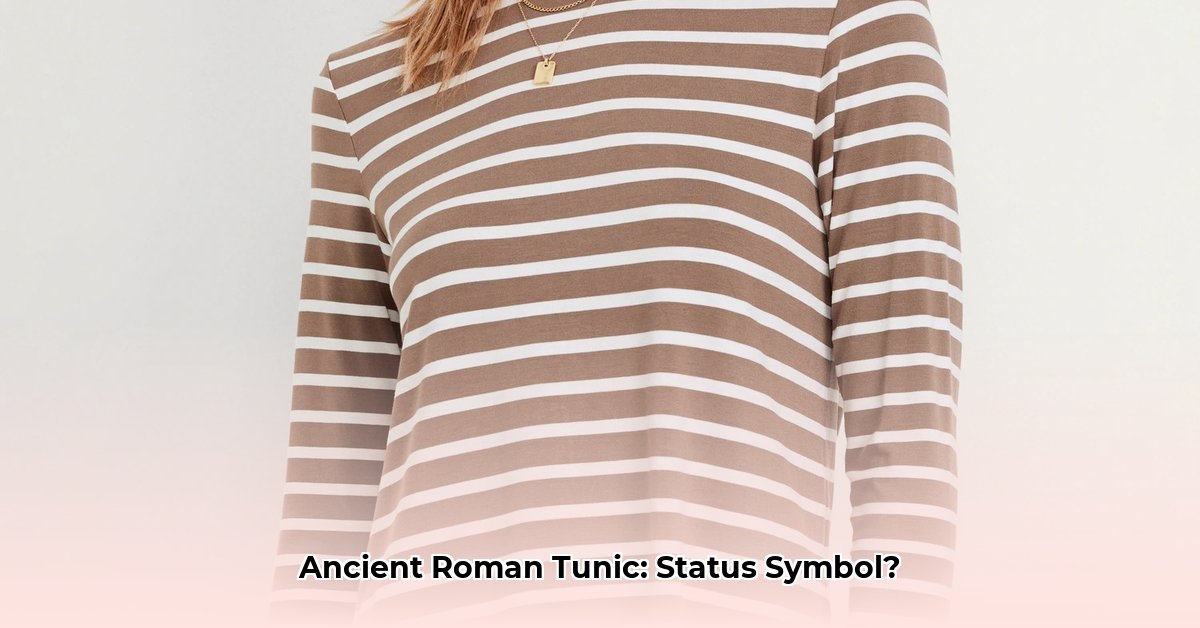Step into the vibrant world of ancient Rome, a civilization renowned for its powerful legions, intricate political systems, and grand architecture. Yet, beneath the epic tales of emperors and gladiators lies a truth far more intimately woven into the fabric of daily life: the profound significance of Roman clothing. More than mere protection from the elements, attire in ancient Rome served as a powerful, unmistakable visual shorthand, broadcasting an individual’s social standing, occupation, wealth, and even their moral character to all who observed them. Learn more about the social hierarchy. Forget the popular image of endless togas; the true cornerstone of Roman fashion was the versatile, ubiquitous tunic. This foundational garment, alongside a myriad of other textiles and accessories, narrated a complex story of identity and hierarchy in every street, forum, and home across the vast empire.
The Tunic: Rome’s Ubiquitous Foundation of Dress
The tunic, known in Latin as the tunica, stood as the quintessential garment for virtually every Roman, male or female, rich or poor, citizen or slave. Its fundamental design was simple: typically two rectangles of woven fabric, primarily wool or linen, sewn together to form a seamless tube, with openings left for the neck and arms. This minimalist construction maximized material efficiency and minimized waste, a testament to practical Roman resourcefulness.
For the vast majority of the population – the working classes, laborers, and enslaved individuals – the tunic was often their sole layer of clothing. These basic tunics were generally made of coarse, undyed wool, reaching approximately to the knee for men and the ankle for women. Their simplicity underscored a life of practical necessity, where comfort and durability trumped any pursuit of elaborate style. During the sweltering Italian summers or for physically demanding tasks, a simple loincloth (subligaculum) might be worn alone, particularly by slaves engaged in hot, strenuous work. Women also commonly wore a breast cloth, known as a strophium or fascia pectoralis, beneath their tunics, similar in function to a modern bra.
Clothing as Status: Decoding Rome’s Visual Hierarchy
While the tunic formed the universal base, its specific characteristics—length, material, color, and ornamentation—transformed it into a nuanced social semaphore, revealing astounding detail about the wearer’s exact position within Rome’s highly stratified society.
The Tunic’s Social Signals: Length, Fabric, and Stripes
The length of a man’s tunic, for instance, carried implicit social meaning:
* Knee-length, short-sleeved tunics were standard for most working men and soldiers, symbolizing practicality and virility.
* Longer tunics (ankle or foot-length) were typically reserved for women, though some fashion-forward men, notably Julius Caesar, adopted them, sometimes drawing criticism for perceived effeminacy from traditionalists.
* Very short or unbelted tunics could be associated with servility or lower status.
Fabric choice was another immediate indicator of wealth. While coarse wool sufficed for the common populace, the affluent adorned themselves in tunics crafted from finer, softer wool, luxuriously smooth linen (often imported from regions like Egypt or Spain’s Saetabis), or even exotic silk.
However, the most unmistakable markers of status on a tunic were the stripes, or clavi:
* Senators and Curule Magistrates (such as Consuls) wore the tunica laticlavia, characterized by two broad purple stripes running vertically from the shoulders to the hem. These wide stripes were a definitive emblem of their elite status and immense political power.
* Knights (Equites), a social class immediately below the senators, wore the tunica angusticlavia, featuring two narrower purple stripes. This subtle distinction allowed for immediate recognition of their specific rank.
The Toga: A Citizen’s Formal Identity
Though not daily wear, the toga remained the iconic symbol of Roman citizenship and public life. This immense woolen semi-circular garment, often weighing considerably and challenging to drape correctly, was reserved for formal occasions, religious rites, and appearances in the Forum. Its impracticality for manual labor ironically became a display of leisure and wealth, signifying that the wearer did not need to work. Foreigners, slaves, and exiles were forbidden from wearing the toga, underscoring its profound symbolic power.
Various types of togas communicated specific roles and circumstances:
* Toga virilis: A plain, off-white toga worn by adult male citizens.
* Toga praetexta: An off-white toga with a wide purple border, worn by curule magistrates, some priests, and freeborn boys and girls as a symbol of their protection under law.
* Toga candida: An artificially whitened toga worn by candidates for public office, symbolizing their presumed purity and catching the eye in a crowd.
* Toga pulla: A dark-colored toga worn during periods of mourning.
* Toga picta: A rare, entirely purple toga richly embroidered with gold, originally awarded to triumphant generals, but later adopted by emperors and Imperial consuls for grand state occasions.
Women’s Attire: Modesty, Status, and Embellishment
For married Roman citizen women, their primary over-tunic was the stola, a simple, long-sleeved, voluminous garment that modestly draped to cover the feet, often belted at the waist or under the breasts. The stola was deeply associated with traditional Roman female virtues, particularly modesty, and provided a visual distinction for respectable matrons. Over the stola, women frequently wore the palla, a large rectangular woolen mantle or shawl, which could be draped in various ways, sometimes covering the head as a veil—a mark of a chaste matron in public. High-caste women and female prostitutes who violated traditional norms were forbidden the stola and might even be compelled to wear a toga muliebris, a “woman’s toga,” as a mark of infamy.
Hair was often intricately styled, particularly for upper-class women, who used wigs, hair switches, and elaborate arrangements like the tutulus. Cosmetics, including face powder, rouge, eyeshadow, and eyeliner, were commonly applied, though some moralists criticized their use. Jewelry, such as rings and elegant fibulae (brooches used to fasten garments), provided further opportunities for personal embellishment.
Freedmen and Slaves: Clothing’s Ambiguous Messages
For freedmen, newly liberated from slavery, clothing was a critical tool for displaying their newfound status and wealth. Though legally forbidden from wearing any form of toga, affluent freedmen sometimes defied this prohibition, leading to satire and even public removal from esteemed seats at games. Urban slaves in wealthy households might wear specific liveries, and cultured slaves serving as tutors could be indistinguishable from well-off freedmen. Conversely, slaves in mines might wear nothing at all. The very idea of slaves wearing uniform clothing was reportedly abandoned due to fear that it would highlight their overwhelming numbers and the vulnerability of their masters.
The Struggle for Status: Sumptuary Laws
Rome’s governing elite, in an attempt to curb perceived excesses and maintain social order, enacted various sumptuary laws. These laws aimed to limit public displays of personal wealth, particularly through restrictions on costly dyes like Tyrian purple and luxurious fabrics such as silk. However, these laws often proved largely ineffective, as the wealthy elite frequently disregarded them, driven by the persistent desire to flaunt their status and acquire fashionable, exotic attire. Human nature, it seems, has a consistent appetite for luxury and distinction.
Materials, Production, and the Roman Textile Economy
The production of Roman clothing was a considerable undertaking, contributing significantly to the empire’s economy, from the rearing of sheep to the skilled work of dyers and fullers.
Fibers of the Empire
- Wool: The most common fiber, prized for its warmth and durability. Regions like Tarentum in Southern Italy, Miletus in Asia Minor, and Gallia Belgica were renowned for their high-quality wool exports. Naturally dark wool was used for work garments, while white wool was preferred for bleaching or dyeing.
- Linen: Increasingly popular from the Mid-Republic onward, linen offered comfort in warmer climates. Notable sources included Spanish Saetabis (whitest) and Retovium (strongest). It was often bleached due to its natural “greyish brown” hue and poor dye absorption.
- Silk: Imported from China as early as the 3rd century BCE, raw silk traded through Phoenician ports like Tyre and Berytus was woven and dyed in Rome. Silk damasks, gauzes, and tapestry were highly prized but astronomically expensive. Sumptuary laws attempted to restrict silk use, particularly by men, as it was considered effeminate by some, and by women, who faced accusations of immodesty. Emperor Elagabalus was famously depicted as the first Roman to wear pure silk garments (holoserica) as opposed to blends (subserica).
- Cotton: Imported from India, cotton was light, comfortable, and, unlike linen, readily absorbed dyes, making it ideal for vividly colored summer wear. Sometimes interwoven with linen for strength and color.
- Other Fibers: Nettle stems and poppy-stem fibers were also occasionally used, sometimes interwoven with flax to produce smooth, luxurious fabrics.
Spinning, Weaving, and Professional Artisans
Spinning and weaving were regarded as virtuous, frugal occupations for Roman women of all classes. Wealthy matronae often demonstrated traditional values by producing homespun clothing, with Emperor Augustus notably proud of his wife Livia and daughter for spinning and weaving his garments. High-caste brides were even expected to weave their own wedding attire on traditional vertical looms.
However, the bulk of fabric and clothing was produced by professionals organized into guilds. Weaving was often done as close to the garment’s final shape as possible to minimize waste. The earliest evidence of more efficient horizontal, foot-powered looms comes from Egypt around 298 CE, but yarn production remained a bottleneck.
The Art of Dyeing: Color, Status, and Trade
The Roman world boasted a wide array of vibrant colors. Dyers, whose profession dated back to early Roman kings, used locally produced, plant-based dyes for reds (madder), yellows (weld), blues (woad), greens (lichens), and browns. Black was achieved using iron salts and oak gall.
The most coveted and expensive dye was Tyrian purple, extracted from the Murex sea snail. Its hues varied from a dark “dried-blood” red to a rich purple, and it was associated with regality, divinity, and protection. Officially reserved for the borders of the toga praetexta and the solid toga picta, its wider use by the wealthy, and somewhat scandalously by some men, persisted despite edicts. Indian indigo provided a costly blue base that could also be used to counterfeit Tyrian purple. Saffron yellow, a bright fiery orange-yellow, was also expensive and associated with purity, notably used for the flammeum (flame-colored veil) of Roman brides and the Flaminica Dialis.
Laundry and Fulling: The Constant Battle Against Dirt
Maintaining clean, bright clothing was a mark of respectability. Most urban Romans, lacking domestic facilities, relied on professional laundries and fullers’ shops (fullonicae). These establishments, though notoriously malodorous due to their use of aged urine in the cleaning process, were essential. Garments were trodden by barefoot workers in tubs of urine, then rinsed, wrung, and dried on wicker frames. Whites could be further bleached with sulfur fumes, while colors were restored by “polishing” with Cimolian earth. This harsh process, while effective, was punishing to fabrics, but the effort and cost were deemed worthwhile, particularly for the senatorial class’s exceptionally white togas.
Specialized Dress: Military and Religious Attire
Beyond civilian wear, specific uniforms and vestments reinforced the distinct roles of the military and various priesthoods.
The Roman Military: Practicality and Identity
Common soldiers typically wore belted, knee-length tunics. In colder northern provinces, warmer, long-sleeved versions became common. Active duty soldiers wore short trousers under a military kilt, often with a leather jerkin or felt padding beneath their armor. The heavy-duty sagum cloak provided protection from the elements and distinguished common soldiers from their highest-ranking commanders, who wore the larger, purple-red paludamentum. While early traditions suggested soldiers wore togas to war (cinched by the “Gabine cinch”), by the Mid-Republic, this was reserved for sacrificial rites. Roman military clothing adapted to local conditions, sometimes adopting foreign garments like full-length trousers, despite conservative disdain for “going native.” The Vindolanda tablets, for instance, record requests for warm socks and underwear for soldiers stationed on Britannia’s northern frontier. Clothing for common soldiers was a significant expense, often more than a third of their annual pay, later replaced by payments in kind during inflationary periods.
Priesthoods: Sacred Vestments and Unique Privileges
Most Roman priesthoods were reserved for high-status male citizens, often magistrates. Religious rites typically required the priest to wear a toga praetexta with the head covered (capite velato).
* Vestal Virgins: Highly respected, their sacred and inviolate persons required their presence at various rites. Their costume was predominantly white wool, featuring a priestly infula, a white suffibulum (veil), and a white palla, adorned with red ribbons symbolizing devotion to Vesta’s sacred fire and white ribbons for purity.
* Flamen Priesthood: Dedicated to various deities, they wore a close-fitting, rounded apex cap topped with an olive-wood spike, and the laena, a long, semi-circular “flame-colored” cloak. The Flamen Dialis, high priest of Jupiter, had unique restrictions but wore the laena which predates the toga.
* Salii (“leaping priests” of Mars): Young patrician men, they processed in archaic warrior dress, including embroidered tunics, breastplates, and a short red paludamentum, striking bronze shields.
* Foreign Cults:










